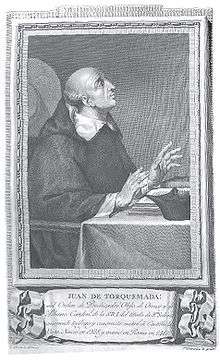Juan de Torquemada (cardinal)

Juan de Torquemada, O.P. (1388 – 26 September 1468), (church Latin Johannes de Turre cremata, various spellings), Spanish ecclesiastic, was born at Valladolid, and was educated in that city.[1]
Life
Juan de Torquemada was born in Valladolid, Spain.[2] At an early age he joined the Dominican Order, and soon distinguished himself for learning and devotion. In 1415 he accompanied the general of his order to the Council of Constance. Thereafter he proceeded to the University of Paris for study, and took his doctor's degree in theology in 1423. After teaching for some time in Paris, he became prior of the Dominican house in Valladolid, and then in Toledo.[3]
Torquemada attended the Council of Basel (1431–1449) as a representative of his order and of the King of Castile. At the Council of Basel he was one of the ablest supporters of the viewpoint of pope Eugene IV and the Roman curia. He was rewarded with the office of Master of the Sacred Palace (4 March 1435), and later with a cardinal's hat in 1439.[3] Torquemada participated in the Council of Florence, speaking on theological issues involving the eastern churches and defending papal primacy in a debate with Cardinal Giuliano Cesarini. He also worked on behalf of Pope Eugene on missions to Germany and France before settling in the Roman curia. As Cardinal of San Sisto, Torquemada supported papal Crusade policy in opposition to the Ottoman Turks. He also defended the conversos of Toledo against accusations that they were not true Christians. (Juan de Torquemada was an uncle of the Inquisitor, Tomás de Torquemada.[4] The latter's fear of "crypto-Jews" might derive from his uncle's defense of the converso community of Toledo.) Torquemada promoted reform of religious houses of his order and of monasteries. In 1456, the new Pope Callixtus III, aka Alfonso de Borja, gave him, in commendam, the position of Abbott of the monastery of Santa Scolastica in Subiaco.[5] This connection may explain his interest in the importation of printing into Rome. The cardinal wrote extensively on behalf of papal primacy. Most notably, his Summa de ecclesia defended the Church against the Hussites and the Roman pontiff against conciliarism.
Torquemada became cardinal priest of Santa Maria in Trastevere (1446-1460), then cardinal bishop of Palestrina (1460-1463), and last cardinal bishop of Sabina (1463-1468). He participated in four papal elections, casting the deciding vote in the election of Pope Nicholas V (1447–1455). He died at Rome in 1468 and was buried at Santa Maria sopra Minerva.
A painting by Antoniazzo Romano showing the Annunciation has in its background Torquemada presenting girls who received dowry funds from a guild he founded to the Virgin Mary. (At an earlier age he was painted by Fra Angelico in a Crucifixion scene now at Harvard University's Fogg Museum.)
Works
Torquemada's principal works are:
- Meditationes, seu Contemplationes devotissimae (Rome, 1467)[4]
- In Gratiani Decretum commentarii (4 vols., Venice, 1578)
- Expositio brevis et utilis super toto psalterio (Mainz, 1474)
- Quaestiones spirituales super evangelia totius anni (Brixen, 1498)
- Symbolum pro informatione Manichaeorum (El bogomilismo en Bosnia) (Publicaciones del Seminario Metropolitano de Burgos. Serie B)[6][7]
- Summa ecclesiastica (Salamanca, 1550) [or Summa de ecclesiastica potestate] or "Summa de ecclesia (Summa de Ecclesia una cum eiusdem apparatu nunc primum in lucem edito, super decreto Papae Eugenii IIII in concilio Florentino de Unione Graecorum - Venetiis [Venice]: apud Michaelem Tramezinum, 1561).
The Summa de ecclesia has the following topical books:
- De universa ecclesia
- De Ecclesia romana et pontificis primatu
- De universalibus conciliis
- De schismaticis et haereticis - divided into two parts, on schism & on heresy.
His De conceptione deiparae Mariae, libri viii. (Rome, 1547), was edited with preface and notes by E. B. Pusey (London, 1869 seq.) in opposition to Pope Pius IX's definition of the dogma of the Immaculate Conception.
Other works include polemical tracts and sermons.
Torquemada's Meditationes was the first illustrated book published in Italy.[8] The first edition of the book was published in 1467 in Rome by Ulrich Han.[4]
Notes
- ↑ Miranda, Salvador Florida International University: "The Cardinals of the Holy Roman Church - TORQUEMADA, O.P., Juan de (1388-1468)" retrieved January 17, 2016
- ↑ Catholic Hierarchy: "Juan Cardinal de Torquemada, O.P." retrieved January 17, 2016
- 1 2 Chisholm 1911.
- 1 2 3 "Meditations, or the Contemplations of the Most Devout". World Digital Library. 1479. Retrieved 2013-09-02.
- ↑ J. Roll, “A Crayfish in Subiaco: A Hint of Nicholas of Cusa’s Involvement in Early Printing?," Oxford Journals, Humanities, Library Volumes6-16, Issue2Pp. 135-140
- ↑ "Symbolum pro informatione manichaeorum : (el bogomilismo en Bosnia) (Book, 1958)". [WorldCat.org]. 2010-01-04. Retrieved 2013-09-02.
- ↑ "Symbolum pro informatione Manichaeorum (El bogomilismo en Bosnia) (Publicaciones del Seminario Metropolitano de Burgos. Serie B): Juan de Torquemada: Amazon.com: Books". Amazon.com. 1958-01-01. Retrieved 2013-09-02.
- ↑ Meditationes [von] Johannes de Turrecremata, ed. Heinz Zirnbauer, Wiesbaden: O. Harassowitz, 1968.
References
 This article incorporates text from a publication now in the public domain: Chisholm, Hugh, ed. (1911). "Torquemada, Juan de". Encyclopædia Britannica. 27 (11th ed.). Cambridge University Press.
This article incorporates text from a publication now in the public domain: Chisholm, Hugh, ed. (1911). "Torquemada, Juan de". Encyclopædia Britannica. 27 (11th ed.). Cambridge University Press.- Izbicki, Thomas M., Protector of the Faith: Cardinal Johannes de Turrecremata and the Defense of the Institutional Church, Washington, DC: Catholic University of America Press, 1981.
- Juan de Torquemada, A Disputation on the Power of Pope and Council, Oxford: Blackfriars Publications, 1988.
- Izbicki, Thomas M., "Juan de Torquemada's Defense of the Conversos," Catholic Historical Review, 1999 85(2): 195-207
External links
From the Lessing J. Rosenwald Collection at the Library of Congress
- Meditationes, seu Contemplationes devotissimae. Mainz Johann Neumeister, 3 Sept. 1479.
- Meditationes, seu Contemplationes devotissimae. Rome, Stephan Plannck, 13 Mar. 1484.
| Catholic Church titles | ||
|---|---|---|
| Preceded by Pietro Barbo |
Camerlengo of the Sacred College of Cardinals 1446 |
Succeeded by Giorgio Fieschi |